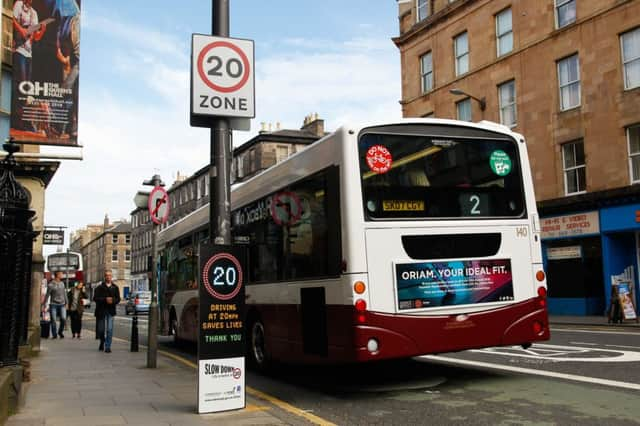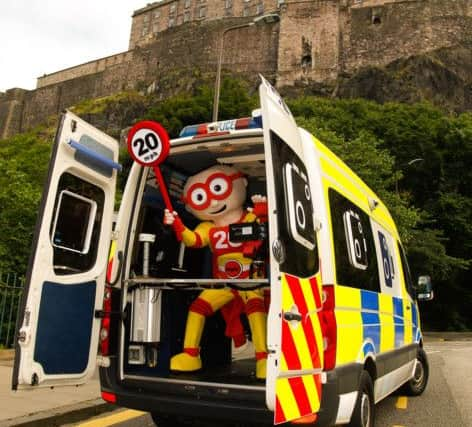Blanket 20mph zone across Edinurgh '˜won't help safety'


IAM RoadSmart claimed the best way to reduce casualties was targeting accident blackspots, not introducing slower “blanket speed limits”.
The organisation believes traffic-calming measures – including speed humps, road narrowing and speed-activated sensors – are key. The charity said that there had been only a “marginal” speed reduction in other UK cities which have adopted a widespread 20mph limit.
Advertisement
Hide AdAdvertisement
Hide AdIt also accused the city council of “putting up signs and hoping for the best” and of adopting the cheapest rather than the most effective option.


Transport chiefs agreed that signs and lines were cheaper, but stressed that 20mph zones “can reduce average speeds and improve safety”.
IAM’s attack comes three days after the controversial £2.22 million scheme’s first phase was rolled out across the city centre and rural west of the Capital.
The pioneering scheme – the first of its kind in Scotland – will eventually cover 80 per cent of the city’s streets following a phased implementation over the next two years.
Advertisement
Hide AdAdvertisement
Hide AdTim Shallcross, head of technical policy for IAM, said: “The problem with speed limits on their own is they lead to an average speed reduction of 1mph when measured in areas such as Bristol, Portsmouth and Islington. It doesn’t have much effect.


“We are in favour of any measures put in place to reduce casualties, but for this to happen we need to genuinely slow down traffic – not just put up a sign and hope for the best.
“Edinburgh seems to be relying on the signs and police enforcement, but with pressures on police budgets it is unclear how effective the enforcement will be.
“Traffic-calming measures in targeted roads is a more robust way of bringing down speed casualties and we feel it generally gives a greater reduction for the money spent.”
Advertisement
Hide AdAdvertisement
Hide AdPolice confirmed yesterday that they had issued no speeding tickets in 20mph zones since they were introduced on Sunday.
Neil Greig, IAM RoadSmart policy and research director, said a city-wide limit didn’t address “specific problematic roads”.
“It’s a blanket approach,” he added. “On some streets, 20mph is a speed that you might aspire to rather than need to limit yourself to. But there are others where it looks and feels safer to go over 20, and that’s potentially confusing because drivers take their cue from the environment.
“If you look at the evidence, what seems to work is measures like speed bumps and narrower roads. Covering whole areas in one 20mph limit and putting up some signs is a cheap way to do it. We’d rather see investment made in dealing with the streets where there will be the most benefit.”
Advertisement
Hide AdAdvertisement
Hide AdAllister McKillop, chairman of Currie community council, said he had received 15 calls from concerned residents following the introduction of the new speed limit.
One of them came from an 87-year-old woman who is considering giving up driving altogether amid concerns she will accidentally incur penalty points.
“Not one person I have spoken to thinks this is a good idea,” said Mr McKillop. “They think it’s not working. They don’t see it as enforceable.
“They don’t see the point of it because of the slow pace of Currie with all the speed bumps. They are confused by the signage, uncertain about when the initiative was even launched.
Advertisement
Hide AdAdvertisement
Hide Ad“They say it’s not been well thought out or explained and some aren’t even sure when it went live. They feel there wasn’t enough advertising and that it’s a total and utter waste of money.
“One 87-year-old woman, who uses her car to drive to the shops, told me she was more worried about looking at the speedometer than looking at the road and that she may just get a taxi from now on.”
Islington was the first borough in the UK to bring in a widespread 20mph limit.
However, statistics collected by Islington London Borough Council suggested traffic slowed only marginally.
Advertisement
Hide AdAdvertisement
Hide AdBefore 20mph limits were introduced, 85 per cent of the traffic on Islington’s main roads was travelling at an average of 28mph. After the limits were introduced, this average decreased to 27mph.
Results from Bristol and Brighton’s pilots of 20mph limits told a similar story – with daytime speeds in Bristol dropping by around 1mph to an average of 23mph.
But city chiefs in Edinburgh denied claims that the new speed limits would not be effective and had not been properly thought out.
The council’s current policy is to roll out 20mph speed limits to the city centre, main shopping streets and residential areas using lines and signs rather than physical traffic-calming measures.
Advertisement
Hide AdAdvertisement
Hide AdBut the council said national evidence has shown that sign-only 20mph speed limits can help to reduce average speeds and improve safety.
Evidence from the pilot scheme in south Edinburgh showed similar results, with average speeds reduced by 1.9mph from 22.8mph to 20.9mph with larger falls in speeds – around 3.3mph – on the roads that had higher average speeds before the limit was introduced.
Transport vice-leader Councillor Adam McVey said: “The introduction of new 20mph limits in Edinburgh follows a great deal of consultation and research, involving stakeholders and community groups from various backgrounds to ensure we strike the right balance for all road users.
“Now that the scheme has begun to be rolled out we intend to work closely with Police Scotland to ensure limits are adhered to, however we’re also relying in a change in behaviour from the public.
Advertisement
Hide AdAdvertisement
Hide Ad“As research shows, for every 1mph reduction in average urban speeds there is a six per cent fall in the number of casualties, and that’s something we can’t ignore.
“Like other 20mph cities including Bristol and Liverpool, the initiative is designed to be sign-only and self-enforcing, reducing the costly and often needless impact of additional traffic-calming measures.
“Evidence has shown that sign-only 20mph speed limits can help to reduce speeds, including during our own 20mph pilot in south Edinburgh, which saw average speeds fall.
“As well as an extensive public awareness campaign, we have installed 20mph signage and road markings fully compliant with the relevant legislation, though also with careful consideration given to the unique context of Edinburgh’s World Heritage status and the need to avoid street clutter, and will continue to monitor its impact on traffic speed and casualties to ensure its effectiveness.”
Advertisement
Hide AdAdvertisement
Hide AdThe News told yesterday that while some motorists reported slower traffic heading into the city centre, many said they and other drivers were continuing to travel routinely at 30mph.
A lack of clarity over affected streets and signage that is not visible enough have been the most common gripes, as some who did adhere to the new rules said they were being overtaken by bikes and facing frustrated gestures from other drivers.
Alex Cole-Hamilton, MSP for Edinburgh Western, said it was essential that signs made it “absolutely clear” where zones start and finish to avoid confusion.
Key arterial routes – including Ferry Road, St John’s Road and Telford Road – are among the few that will retain their 30mph limits.
Advertisement
Hide AdAdvertisement
Hide AdThe proposals were initially met with a groundswell of opposition, with upwards of 2700 people signing a petition calling for the decision to be reversed.
But city-wide consultations have also reported positive feedback – amid some remaining concerns around increased congestion, road safety and longer journey times.